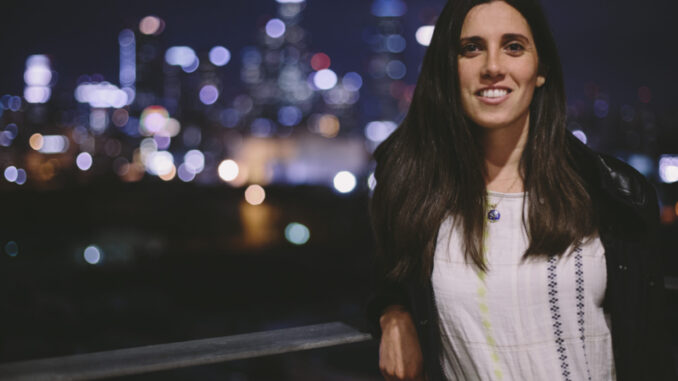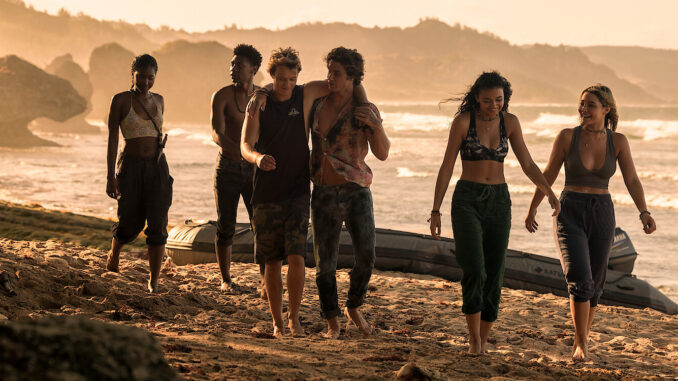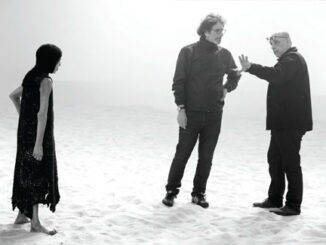
By Rob Feld
Nicole Vaskell attended film school at USC for directing, but while there, she discovered editing and documentary filmmaking.
“I was trying to stylize everyday life experiences through a lot of manipulation, and I realized that through editing, I could say so much of what I had wanted to through directing,” she recalled. “Controlling the story was easier in the editing room and I could spend hours in those Avid bays, seeing all of my options.” During her last few semesters, she found an assistant job at a commercial post-production company, where she learned how break down hours of footage and interviews, and craft stories through montages. She also got to cut music videos for Bad Religion, the Offspring, and Cold War Kids.
Vaskell cut two feature documentaries and began assisting David Crabtree, who brought her on to the series “Rosewood,” where she was quickly bumped up to editor. Now part of the respective teams cutting “Outer Banks” and “Bel-Air,” Vaskell calls upon her diverse experience but most notably her documentary past for “Outer Banks,” which runs on Netflix. The action-adventure drama follows the conflict between two groups of treasure-hunting teenagers in the Outer Banks of North Carolina. The tale of insiders and outsiders, with most episodes directed by co-creator Jonas Pate, incorporates improvisation and is shot in documentary style to capture the unexpected. This leaves series editors like Vaskell with a mass of footage to manage and sift through, to find the moments that enlighten.
CineMontage: What did you learn from your first time working in a television framework, with David Crabtree on “Rosewood”?
Nicole Vaskell: How to communicate and collaborate with multiple showrunners. It’s mediating, trying out everyone’s idea and being quick about it; being as diplomatic as possible and having an opinion, but not being too aggressive. I love it. It’s the perfect social experiment. And from a technique standpoint, David taught me a lot about cheating performances. In documentary, you don’t really do that because you don’t have multiple takes of actors doing the same thing on a mark. Now, that’s all I do—I’m split screening to fabricate performances and making sure I’m creating the most authentic pace for the characters and story. A lot of that is done through editorial tricks that I learned from David.
CineMontage: The mode of filming “Outer Banks” is a little unique. Can you describe the footage with which you are working?
Vaskell: It’s a scripted show but it shoots most of its material doc style, meaning there can be around eight hours of footage a day. There’s a lot of spontaneity, loose blocking, and improvised dialogue, action, and camera work. So, each take is never the same. It’s all shot on location in the swamps of South Carolina where the cicadas are just running wild, which provides its own set of challenges with sound. But it’s incredible to work with. The way Jonas [Pate] shoots is with three or four cameras, kind of 360 degrees at all times. So, everything is captured from many different sizes and angles. Then we mine for gold. You get all these moments that wouldn’t be captured with traditional setups. Then there’s something like an editorial freedom to interpret the essence of the scene and create something new from it, which is what Jonas, Josh Pate, and Shannon Burke were looking for me to do when I came on with my documentary background.
CineMontage: Have you found that leading to a unique relationship with the showrunners?
Vaskell: Totally. We get a lot of time to work on it and we have an incredible supervising editor/producer, Sunny Hodge. After I finish an assembly, I work with her first to make sure that the tone and the essence of it are in line with how the Pate Brothers think. Then we’ll work with Shannon, Josh, and Jonas. It’s incredibly collaborative. It’s, “This is a great way to interpret the scene, I love what you did, now let’s try this…” A lot of “Outer Banks” is told through music, with songs and score. Josh puts together these incredible playlists at the beginning of every season—I’ll go through them and keyword which songs each character would listen to or what vibe compliments a character or a sequence. Then I’ll have a starting point for where I can go musically. The experience is exploratory, which it should be. When you have that much footage, you can’t just assume there is one way to cut it.
CineMontage: What have you determined to be the rules for cutting the show?
Vaskell: That’s a good question. We have a lot of giant wide shots and huge drone shots that encapsulate the beauty of the landscape and in Outer Banks. We try to incorporate those where we can. The actors have great ad libs and moments of levity during some heavy plot scenes, which are always appreciated. So, we try to interject that quite a bit. That will influence a cut. Also, the camera work—we have really slick handoffs from character to character, which aren’t necessarily planned. I don’t want to bore the viewer with cut, reverse, cut, reverse. It’s always finding those shots in the coverage that naturally hand off to one another. They’re not always planned, so we’re always finding the next shot that’s going to progress the cut in a way that seems fresh and unexpected. A lot of that tends to do with movement and camera. Jonas also strives to get shots with a dirty foreground, shooting from behind a plant or something. He’s always yelling, “Dirty it up!” Making sure we have the dirty version of the shot to push it forward lends the show a feeling of naturalism. It’s also easy when you’re cutting with dirty footage to cheat a cut.

CineMontage: What’s the greatest narrative challenge for you? There are a lot of characters, each with their own life.
Vaskell: It’s a treasure hunting, coming-of-age teen drama. A lot of the characters are going through big changes. So, the biggest narrative challenge is making sure that each one of their emotional states are grounded, we’re empathizing with them, and we’re checking in with them. And that means slowing it down at times, holding on these closeups, and really letting the audience see what the character is going through in the expressions on their faces. Jonas regularly sits on a closeup through extra beats, so we always have the ability to button a scene by checking in with our character. Another narrative tool we use is to montage through a lot of story with voiceover, which helps push the plot along, but it also helps ground where we are with that character emotionally. If you ever get lost with plot, that helps you fall back and reconnect.
CineMontage: How does this work compare with your process on “Bel-Air”?
Nicole Vaskell: I’ll start about a similarity. What’s interesting about both shows is they lean heavily on music. Not just score, but needle drops to heighten cinematic drama and emotion. “Bel-Air” is a much more traditional one-hour drama, mostly shot on stage. “Outer Banks” is all location but at the core is still a character-based drama. So, the major difference is really just how I go about breaking down the footage. With “Bel-Air,” I can rely on my assistant to go through the script the dailies, whereas on “Outer Banks,” I’d break down the footage completely differently than how I would break down the footage. On “Bel-Air,” I could do a straight dialogue edit, finding the best performances and cheating the best reactions to get the best connection between my characters. You have to approach “Outer Banks” way more like a documentary, finding moments. When I build my scene, I may not build it with dialogue first. Sometimes, I may build it with all the great looks and moments first, then I’ll bring in my dialogue. It’s a much more layered process, whereas “Bel-Air” is more straightforward and based on the script. When I’m working with my show creators on “Bel-Air,” we are looking at the script and making sure our lines are in line with what was written and the intention. With “Outer Banks,” once we have the footage, we’re working with what we have.
CineMontage: How has your perspective changed from the time you were in film school? Have you garnered something new about storytelling?
Nicole Vaskell: Totally. From a craft perspective, I’ve come to appreciate just how collaborative this field is. Working with people I respect and admire is so rewarding. When you’re an 18-year-old, you think your idea is the best. From a storytelling standpoint, it’s really come down to helping create authentic characters and genuine moments that are either very relatable to audiences, or that audiences can empathize with what they’re going through. I appreciate putting together stories in a way that help an audience connect to a character. That’s what keeps me going. Twenty years ago, I would’ve given you a much different answer.






